#Justinian
Text
TIL from a podcast featuring historian and Byzantine archaeologist Yannis Theoharis:
Athens was one of the most religiously conservative cities of the Byzantine Empire. It adhered to the ancient Greek religion for longer than most other areas. Contrary to popular belief, its eventual conversion to Christianity did not happen violently. Christianity was getting more and more ground amongst the believers progressively. Meanwhile, the ancient temples and shrines were progressively emptying but as long as there were believers they were functioning properly and had guards and went through restoration works and all, as stated by Neoplatonic philosopher Proklos (with the exception of nude sculptures which had been destroyed already by proto-Christians). The historian also claims the conversion of the temples to churches happened later than what was previously believed, around the 7th-9th centuries. As the vast majority of the population had eventually converted to Christianity, the temples were left abandoned. The empire ordered their conversion to churches so that funding their preservation could be justified. Furthermore, there wasn’t as much of violent banning of ancient schools as it was thought. Justinian did not ban the function of the Neoplatonic school in Athens but ceased the state funding unless the school accepted to add Christian theology to its curriculum. The Neoplatonic school refused but it was not banned. It kept functioning using its own private funds until this wasn’t enough and the school had to close. Evidence for this is that it is documented that the school functioned for several decades or more than a century (don’t remember exactly) after Justinian’s imperial command, which was previously viewed as an immediate or violent shutdown. Meanwhile, the Neoplatonic school in Alexandria (in Egypt) agreed to add Christian theology to its curriculum and it kept functioning undisturbed until the 7th century and the Arab conquest.
Also, he has more insight into the similarities observed between Eastern / Greek and even all Orthodoxy and the Ancient Greek religion, such as idol / icon worship, lesser deity / saint worship, virgin female deity / super saint worship, patron gods / saints etc He says there was an interesting cycle of Christianised Hellenism followed by Hellenized Christianity. Some of these elements of Christian Orthodoxy were emphasized more than in the early years of Proto-Christianity or even exaggerated by the Byzantine Greek Christians in order to attract the pagan Greeks and make them understand more easily the philosophy of the new religion and find common ground between them. It worked.
Lastly, he disputed the dated assumptions that the Visigoth king Alaric I was assisted by monks to destroy Athens during his invasion in 396. This was falsely concluded because in documents it was found that Alaric was accompanied by men clad in black. Theoharis says these were actually Thracian soldiers (Alaric indeed fared long in Thrace and the Thracians were by large mercenaries) and supports it is very unlikely based on historical evidence of the time that Athenian or Greek Christians would collaborate with a Visigoth invader to help him destroy historical areas of Athens, even if they were pagan.
These are the most important bits from memory, I am linking the podcast here, it is in Greek.
#Greece#Europe#history#Greek history#Byzantine history#Christian orthodoxy#Ancient Greek religion#Greek orthodoxy#Eastern Orthodoxy#Byzantine empire#eastern Roman Empire#justinian#Alaric I#proklos#neoplatonism#Athens#attica#central Greece#Sterea Hellas#mainland
87 notes
·
View notes
Text


Early Byzantine, The Emperor Justinian and Empress Theodora with their Court Retinues, ca. 547, mosaic (San Vitale, Ravenna)
Mosaics in situ (flanking apse windows beneath Christ in Majesty mosaic), details of Emperor and Empress
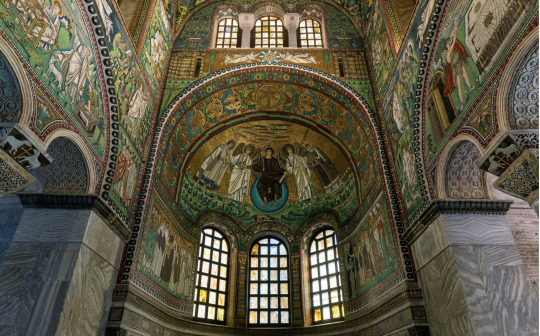
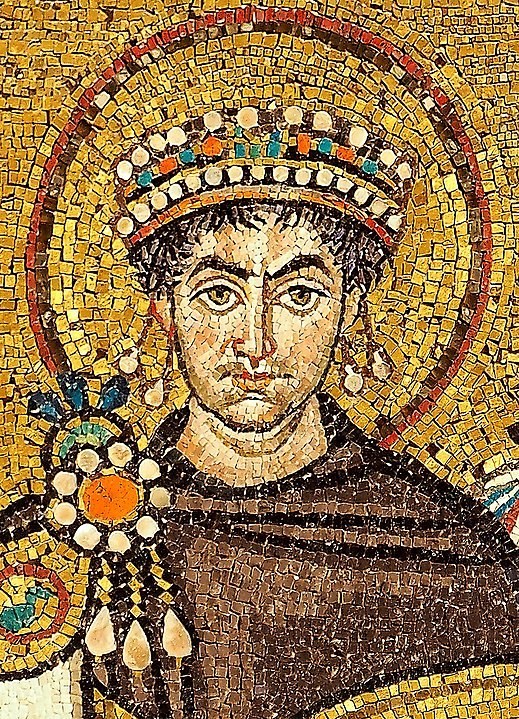

680 notes
·
View notes
Text

Justinian and Theodora romance sketch! I totally love these two as a couple-- the courtesan that married a prince!-- and there's not much art for them out there. So here it is, @byzantine-suggestions and @margaretkart!
#justinian#justinian and theodora#theodora#empress theodora#art#illustration#sketchbook#sketch#romance art#byzantine empire#byzantium#ancient rome
74 notes
·
View notes
Text
Empress Theodora entering Hagia Soph..
oh wait, it's Alicent.
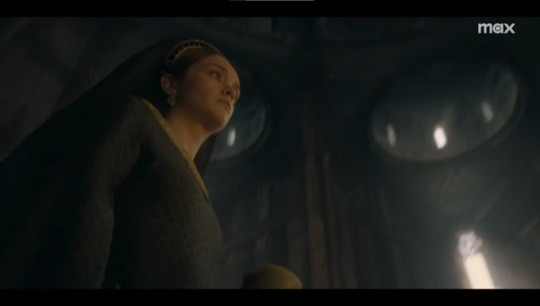
#byzantine#byzantium#game of thrones#house of the dragon#hotd#alicent hightower#rhaenyra targaryen#daemon targaryen#hagia sophia#constantinople#roman empire#late roman empire#late antiquity#house targaryen#team green#team black#hbo#hbo max#theodora#justinian#empress
21 notes
·
View notes
Note
What do you think of Justinian's reign as emperor? A new biography of him that gives fairly positive conclusions on his reign just came out at around the same time as Anthony Kaldelis new history of the byzantines which has a basically equally negative reading of the same subject.
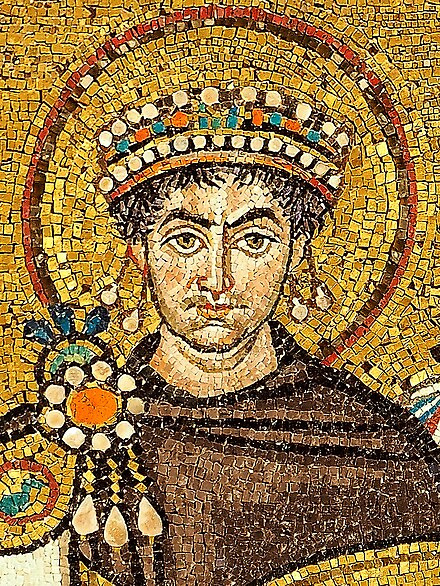
An odd mix of extreme competence in many areas of governance, but so much of that energy was directed at an impossible and arguably counter-productive goal.
He should have stuck with North Africa and the Mediterranean islands so as to preserve his resources for the more important conflict with Khosrau of Persia, rather than waste blood and treasure trying to conquer an empty Rome.
35 notes
·
View notes
Text
Little Hagia Sophia 🕌


#Little Hagia Sophia#Byzantium#Art#Architecture#Justinian#Greek Orthodox#Church#Ottoman Empire#Mosque#Istanbul#Turkey
12 notes
·
View notes
Text
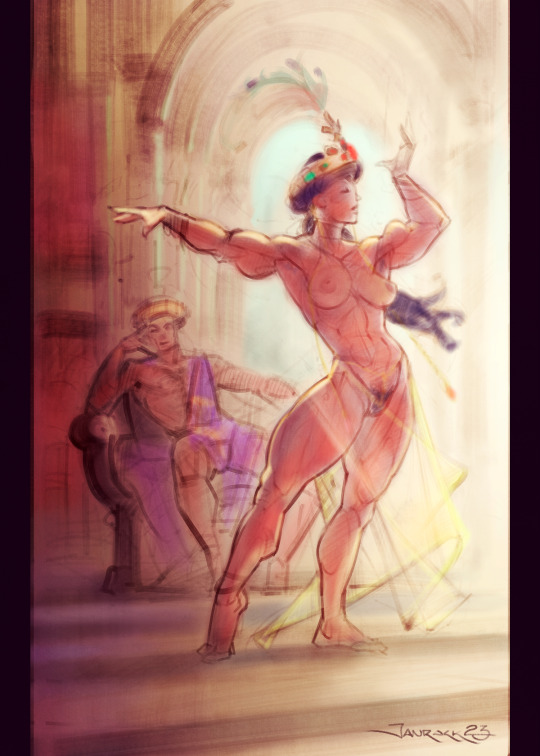
Sketching.
138 notes
·
View notes
Text






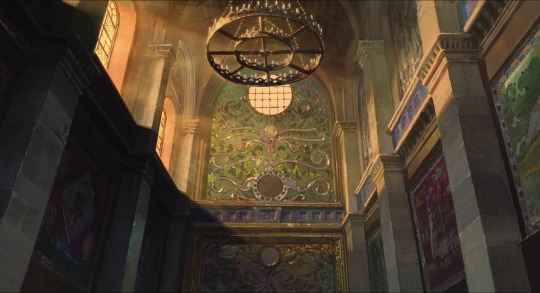
The Byzantine (Eastern Roman) influences on the designs of the 2006 Japanese anime "Tales from Earthsea" (ゲド戦記) by Gorō Miyazaki.
#greek culture#byzantium#byzantine#ghibli animation#studio ghibli#miyazaki#constantinople#eastern roman empire#justinian#greek history
79 notes
·
View notes
Text
The HILLSBOROUGH DISASTER has NOTHING on the NIKA RIOTS
ON THIS DAY, 532 AD



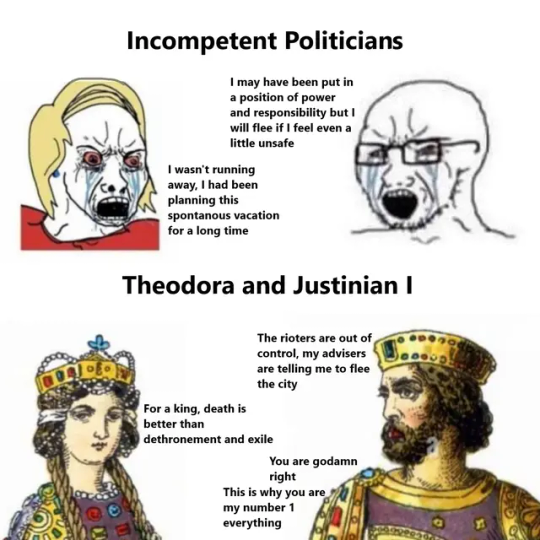

#history#ancient history#classics#ancient greek#ancient greece#ancient rome#roman#greece#constantinople#justinian#theodora#sport#sports#on this day#on this date#medieval#middle ages
19 notes
·
View notes
Text
Porphyrios

Since 2020 there have been over 400 run-ins with orca whales off the coast of Spain. So far, they've sunk at least three ships and damaged dozens more. A ship's skipper, Daniel Kriz, who has had the orcas damage rudders on two different boats he's been on, says they're getting better at it too.
“In 2020, the attack lasted almost an hour and was not as organized,” Kriz said. “This time we could hear them communicating under the boat. It only took about 10 to 15 minutes.”
Why are whales suddenly going after boats with such determination and for such a long span of time? Scientists are unsure, leaning between the whales retaliating for harm a ship did them previously or simply becoming brave enough in their curiosity to unintentionally damage ships. Perhaps I am a bit too influenced by stories I've read but I would tend to believe the orcas know exactly what they're doing.
I also know this isn't the first time a whale has attacked, or sunk, a ship.
Perhaps the most modern famous one is the sperm whale that sunk the whaling vessel Essex in 1820, an incident that inspired Herman Melville to write Moby Dick in 1851.
But we can go further back than that.
Much further.
Let's go back to sixth century Constantinople. According to Procopius, a historian of the time from Caesarea, a great whale, 45 feet (13.7 meters) long and fifteen feet (4.6 meters) wide haunted the Strait of Bosporus and the waters around it. This whale wasn't just there to sight-see either. The whale attacked and sank ships it came across.
The sailors of the time named the monster Porphyrios.
There's debate what the name was derived from (other than the gut kick reaction to shout 'oh shit!' the second you saw the whale hove into view) but most scholars think the whale's name came from prophyra which meant a deep, purple color. This could have been referring to the color of the whale's skin or perhaps imbuing it with some of the terrifying, regal nature that nobles of the time, the only ones allowed to wear the purple, implied. Whales weren't well known in that area of the world at that time and we have no way of knowing what kind of whale it was. Speculation based on size leads many to believe it was a lost sperm whale a long way from home but it might have also been a large orca. Iberian orcas hunt the Straight of Gibraltar, following the bluefine tuna every year and they're the ones responsible for the recent ship attacks off the coast of Spain of the past few years. It's not hard to imagine one of them wandering east, deeper into the Mediterranean Sea, instead of heading back north when the tuna left. And Porphyrios didn't just set up shop anywhere. He decided that the Strait of Bosporus was his new hunting ground.
Here's the thing. The Strait of Bosporus was the main trade route for that part of the world. Goods flowed down to the Black Sea, crept through the narrow Strait of Bosporus which let out into the Sea of Marmara. One more strait, this one the Dardanelles, where the city of ancient Troy once controlled all trade out of the East, and then it was out into the Aegean Sea and then on to the Mediterranean. Trade goods could pass by on land but it added both dangers and time to the business and, most importantly, took all that sweet, sweet toll to use their water passage right out of Constantinople's hands. Having what amounted to a sea monster living in their main money-maker and convincing merchants to find other ways to bypass the strait, and therefor the city sitting on the edge of it, was disastrous for a country that was trying to restore itself to its former glory. Emperor Justinian I, also known as the Great, put out a bounty on the monster's head and did everything in his power to encourage its capture or eradication.
The tools of whaling used centuries later to drive many whale populations to the brink of extinction however were unknown at the time. Porphyrios shrugged off the arrows and spears lobbed at it and went on sinking ships, sending simple fishing vessels to the bottom of the ocean just as steadily as it did merchant and war ships. There was even a story that Justinian's famous general, Belisarius, loaded a catapult onto a ship to hunt the deadly whale, though this seems to be just a story and one which also failed to killed the great monster of the strait.
Porphyrios becoming a terror that merchant captains probably saw in their nightmares even when they were on dry land. Long routes far out of the way were taken to avoid waters he swam in. There would be lulls. For unknown reasons, Porphyrios would disappear for long periods of time, lulling ship captains and their crews into thoughts that the monster had died. It never lasted though and for over fifty years, Porphyrios hunted the ships of the Bosporus and its surrounding waters, damaging some and sending many more to the bottom of the ocean.
Nothing lasts forever though. One day, the story goes, Porphyrios was chasing dolphins in the Black Sea and ran aground. Struggling to get back to deeper water, it only churned up the dirt, sinking itself more completely into the mud. Locals that lived nearby saw what was happening and ran out to kill the great beast but their axes did little damage against its tough hide. In the end, they lashed ropes to to the whale and, using horses and wagons, dragged its great bulk to higher ground. There they finally managed to kill the beast, eventually hacking it to bits and eating the pieces. Porphyrios, killer of men and sinker of ships, terror of the Bosporus, was no more.
It was the first recorded case of a whale attacking ships.
It hasn't been the last.
Perhaps the Iberian orca, social animals that can teach each other how to disable and sink ships, tell stories, late at night when they rest in the waters off the coast of Spain, with the bright lights from the shore twinkling above the water like electric stars. Perhaps they tell stories of an ancestor who hunted strange waters -
and taught the humans in their noisy ships above what real fear was.

#porphyrios#whale#whales#orca#sea monster#history#constantinople#justinian#killer whales#orcas#turkey#bosporus strait
10 notes
·
View notes
Text
Danse Macabre, Rise
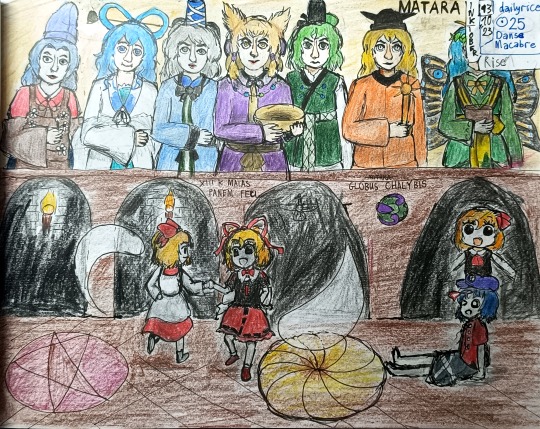
DRC25 - INK13
The inspiration for this piece is the San Vitale Basilica's wall mosaic (shown below) depicting Justinian I (6th century Eastern Roman Emperor) and his retinue.

I shall try my best to explain the Byzantine complexities that are present here:
Toyosatomimi no Miko (Shoutoku Taishi) as Justinian I: The most obvious reason here is that they were both kings who reigned in the 6th (7th) century AD. Even though Justinian passed away before Shoutoku came to power, I took creative liberties with bypassing this fact - Shoutoku's true contemporary, Heraclius, only has his face depicted on a coin - which is anything but sufficient.
Mononobe no Futo (Mononobe no Moriya?) as Flavius Belisarius
and Soga no Tojiko (Soga no Umako?) as Narses the Armenian: The relations between these two and Miko are not unlike Justinian and his generals. Even Belisarius and Narses quarreled with each other, much like the friction between the Mononobe and Soga clans in Shoutoku's reign.
Matara Okina (Hata no Kawakatsu / Matara-jin) as the bishop Maximianus of Ravenna: Both of them served the king, and both of them had religion-related professions - those are the only connections I could find.
Other than the aforementioned characters, the remaining people depicted on the mosaic could not be identified with anyone in particular; rather, they were simply generic elements of the king's retinue. Thus, I also took creative liberties in depicting them:
Eternity Larva (Tokoyo-no-kami): This kami (god) is Matara Okina's enemy, as indicated by Okina's dialogue in Hidden Star in Four Seasons' extra stage (Cirno's scenario).
Kaku Seiga, Miyako Yoshika (Miyako no Yoshika): Their dynamic needs few explanations. Seiga is the master, Yoshika is her undead servant. Moreover, Yoshika is depicted in her living form - inspired by the fan-work "Suikakasen" by Joyfull.
As for why I did not choose Theodora's mosaic as a reference, I simply forgot about its existence until much later. Even so, I found Justinian and his retinue to have much in common with Shoutoku and his contemporaries.
#touhouproject#koubudraw#dailyricegrains#inktober2023#toyosatomimi no miko#mononobe no futo#soga no tojiko#yoshika miyako#seiga kaku#eternity larva#okina matara#rin satsuki#medicine melancholy#rumia#san vitale basilica mosaic#justinian#shoutoku taishi
10 notes
·
View notes
Text
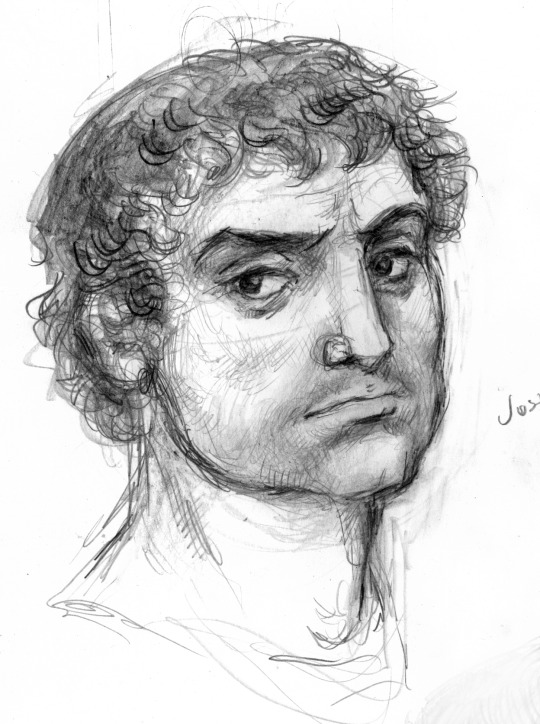
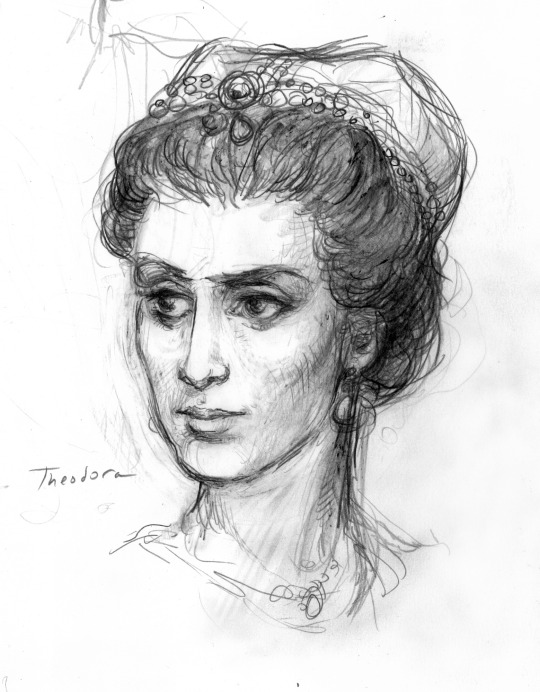
Good-bye 2023, hello 2024! One of my New Year's Resolutions is to draw more (whispers-- and to catch up on my commissions) and here are sketches of Byzantine emperor Justinian and his wife Theodora, based on the famous San Vitale mosaics and these busts of Justinian (and the bust of Theodora in Milan here).
#justinian#theodora#empress theodora#illustration#art#sketchbook#sketch#byzantium#byzantine empire#byzantine#justinian and theodora
90 notes
·
View notes
Text

Procopius of Caesarea, c. 500?-c. 560?, the last major Classical Roman Historian (not "Byzantine" in the narrow sense) .Our major source on the reign of Justinian (apart from his laws of course).
Historical fanart by @sekihamsterdiestwice
Circa 540-550, Procopius was furiously scribbling something, the only thing he could do after retiring from his position as "legal counselor". In his hand is an ancient Greek comic mask for his favorite author, Aristophanes. He was extremely fond of quoting his Cloud, especially in the Secret History.
Photios, the 9th-century Patriarch of Constantinople, believed that Procopius was actually a greater author of (Greek) history than Thucydides, or in his words, the most brilliant "rhetor" in the field of historical writing. He was unaware of the existence of Secret History. The appearance (in the 17th century) and utterly confirmation (in the late 19th-early 20th centuries) of Secret History would revolutionize the perception of Byzantine and Roman history.
Procopius' perception of himself as a rhetor and a jurist is also unified. In fact he considered rhetoric to be a necessary condition of jurisprudence. And historical writing, likewise, is a necessary extension of rhetoric. This also explains why he took up historical writing after his “compulsory retirement” from his post as "legal adviser" to Belisarius, the two "disciplines" being completely separate in modern scholarship. But at that time they were united by "rhetoric".
In any case, Procopius's rhetorical achievements make the reign of Justinian and the Mediterranean world of the early 6th century one of the most richly depicted periods of Roman history. But such a detailed picture is highly problematic. For Procopius presents three very different works: one seemingly objective and even somewhat propagandistic Wars, one very erotic and violent Secret History that is entirely abusive of the emperor and his regime, and one Buildings that glorifies the emperor, who had previously been criticized to the point of inhumanity.
Behind Wars, Secret History, and Buildings are there three Procopiuses, or is it the metamorphosis of one Procopius? If the former, why does he present himself as three very different persons? If the latter, how does this one man reveal his true self under three very different faces? This is in fact the central topic of the study of Procopius. And one simply cannot begin to study the period in which he was writing without first realizing this question. And this question is the mystery that Procopius' masterful rhetoric has left for future generations.
4 notes
·
View notes
Text

A 6th century mosaic image of Byzantine Emperor Justinian is in the Basilica di San Vitale in Ravenna, Italy. To his left is Bishop Maximianus of Ravenna with a label above his head.
3 notes
·
View notes
Text
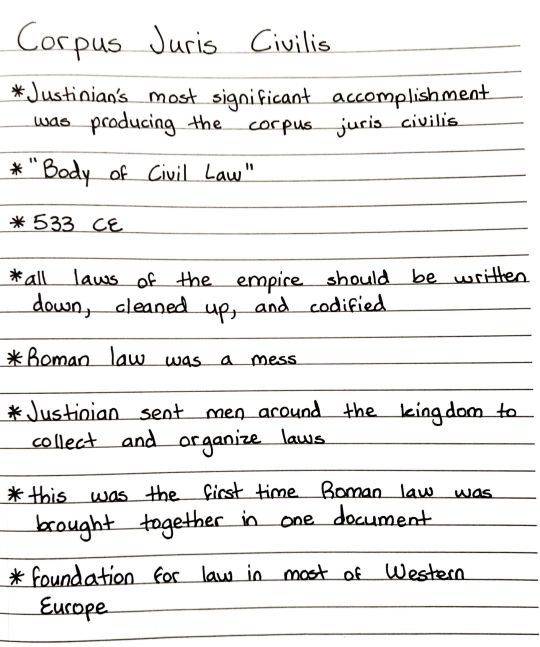
Patreon
#studyblr#notes#history#historyblr#history notes#world history#world history notes#western civ#western civilization#western civ I#western civ 1#justinian#emperor justinian#roman history#classical studies#roman emperors#roman law#ancient law#corpus juris civilis#european history#rome#ancient rome
9 notes
·
View notes
Note
For Finny: Justinian
Today's Terrible Original Finny Name Suggestion is...
Justinian
Submitted by anon
(Mod UT: It wasn't specified, so I'm posting it as terrible. More legit names for him might be in German?)
3 notes
·
View notes